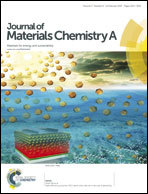Formation of copper vanadate nanobelts and their electrochemical behaviors for the determination of ascorbic acid†
Abstract
Copper vanadate nanobelts have been successfully synthesized by a facile hydrothermal process using sodium vanadate and copper acetate as the raw materials, and the polymer polyvinyl pyrrolidone (PVP) as the surfactant by adjusting the pH value. The nanobelts are characterized by X-ray diffraction (XRD), scanning electron microscopy (SEM), transmission electron microscopy (TEM) and high-resolution TEM (HRTEM). XRD and HRTEM show that the copper vanadate nanobelts are composed of a single crystalline monoclinic Cu2.33V4O11 phase. SEM observation shows that the copper vanadate nanobelts have the thickness, width and length of about 50 nm, 300 nm to 1 μm and several tens of micrometers, respectively. The pH value plays a key role in the formation of the copper vanadate nanobelts. The growth process of the copper vanadate nanobelts has been proposed as the nucleation and PVP adsorption growth mechanism under acidic and alkaline conditions. Copper vanadate nanobelts have been used as glassy carbon electrode (GCE) modified materials for the determination of ascorbic acid showing good electrochemical detection performance. The linear range is 0.001–2 mM and the detection limit is 0.14 μM and 0.38 μM for cvp1 and cvp2, respectively. The copper vanadate nanobelt modified GCE exhibits good stability and reproducibility.


 Please wait while we load your content...
Please wait while we load your content...